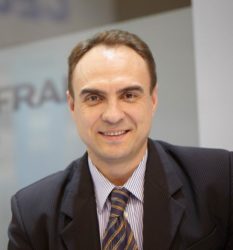

Michael Keie
Managing Director
ART-Line Projekt GmbH, Germany

Topic: Combatting Counterfeit Identities: Securing the Nation with Trusted Identities and Secure Transactions
Speaker: Wayne Fletcher
Global Director of Government Vertical Marketing
Entrust Datacard, USA
Creating a strong chain of trust to facilitate access to citizen government services
Effective document security requires a new integration of technology and methodology to ensure that a Secure ID document is resistant to simulation, alteration, and easy to verify with confidence. Strong security features bring together 3-elements: specialized engineering, restricted components, know-how & expertise, with the integration of overt, covert, and forensic features. Security at Time of PersonalizationT methodology leverages features based on variable data; unique to the document and the bearer that is added during personalisation and linked with substrate features bringing multiple benefits.
Incorporating digital identity technologies during enrolment and issuance to digitally sign and bind the identity to the credential significantly increases security and creates a strong chain of trust from issuer to the credential to the authentication system that requires the proof. Attendees will leave this presentation with an understanding of how to effectively combine physical and digital security technologies to support trusted identities without sacrificing convenience for citizens and employees.
Speech bullet points
Physical IDs remain critical to delivering trusted identities in today’s increasingly digital world.
Combining physical and digital security empowers governments and businesses to more effectively validate identities and support secure transactions.
Case studies will provide actionable insights that other organizations can apply to their evolving eID strategies.

Topic: ID document and physical security
Speaker: Sergey Rudominskiy
Regional Sales Director for CIS
OT – Morpho, The Netherlands
The purpose of an ID document such as a passport is to prove the identity of the owner. Therefore, one must be able to check whether the passport is genuine, not altered and belongs to the holder.
Passport forgery is developing continuously and now comprises methods like sticking an overlay with portrait image and personal data over the data page, grinding away the back of the data page to access the personalized layer, or adding laser engraved personalization.
To ensure protection, authorities shall start with an analysis of the threats (which documents are frequently reproduced or altered; what techniques are used by forgers).
The most common passport fraud techniques are:
1. Copying a document, i.e. counterfeiting an entire passport. Sometimes security features from lost or stolen passports are used in combination with commercially available material.
2. Changing the data on a legitimate document by substituting or altering the photo and altering or deleting (biographical) information.
3. Stealing a blank document and personalizing it with false data.
4. Look-alike fraud: misuse of a genuine document belonging to a similar-looking person.
The features that are selected in the design process must protect against all types of threats. Some guidelines to address the known and future threats are:
• Use feature technologies that are difficult to copy (anti-scan patterns, rainbow printing, clear window, CLI/MLI or Optical Variable Devices);
• Combine security features to make it more difficult for a counterfeiter to master all the various techniques (printing, lamination, laser engraving);
• Combine tactile (feel) and optical (look) features for faster inspection and protection against an overlay. Lenses are particularly effective against copy and are easy to check;
• Insert personal data inside the document structure, not just on the surface, to make it more difficult to reach and change it;
• Combine and connect personal data and security features to prevent forgery without visible damage to the document;
• Duplicate personal data, using various techniques;
• Integrate and interconnect security features to prevent recycling of security features;
• Use specific inks and components that are only sold to secure printers and have no successful imitations publicly available.
Morpho recommends Polycarbonate (PC) documents because:
• The personal data is written with laser into the document material (not on the surface);
• Polycarbonate documents cannot be split and features are protected inside the document body (known as mono-block concept);
• Polycarbonate offers the possibility to create security features in different layers of the document body (use of third dimension/depth of the document);
• Tactile features like tactile relief and laser raised characters can be applied on Polycarbonate;
• Polycarbonate offers possibility to create optical variable effects and 3D effects through the use of lenses:
o Today: lenticular lenses (MLI/CLI, SLI:registered:/3D Photo);
o In the future: spherical lenses (Moiré magnification) for images that seem to float or sink below the surface of the document.
• No consumables are used in personalization, therefore no need to safeguard transport or storage of consumables;
• Polycarbonate has a high resistance to heat and flexing and therefore is more durable than paper or PVC;
• Polycarbonate offers good protection for the chip.
Furthermore:
• Morpho prints fine line structures in PMS colors at 10,000 dpi in waterless offset, resulting in very high quality print that cannot be reproduced by regular (non-security) offset printers;
• The biographical data is laser engraved beneath the printed security design. Alteration of data from the top leaves clear and visible traces;
• Morpho uses “Personalized” features like 3D Photo and SLI:registered: (the photo image is a security feature in itself) to make personalization of stolen blank passports very difficult and to protect against the main type of fraud which is Photo-substitution;
• Morpho promotes the “less is more” philosophy:
o The passport shall be easy to inspect. Only a few, strong, interlinked security features on strategic places in the document shall be communicated for visual inspection;
o These features shall look unchanged through the required validity period and shall be manufactured with a minimum of variation to make detection of the differences with a fake passport easier.
• Morpho applies Image processing software to prepare the photo images for best quality printing or laser engraving, taking into account the characteristics of the substrate (e.g. PC) and personalization equipment (e.g. Muehlbauer, Datacard, IAI). This ensures that even “low quality” passport photos will be personalized as bright, sharp photo images, rich in contrast to fight look-alike-fraud.
• Morpho anticipates the need to speed up the document verification (air traffic growth…) and increase the efficiency & reliability of the verification even for non-specialists. As a result of that need we see a transition from Human to Machine (automated) authentication. Automated border control gates are one example. Also people now have immediate access to the latest technology such as smart phones with high resolution cameras. More and more smartphones are used as “tools of the trade”, replacing dedicated and specialized equipment. Therefore Morpho is developing new security features specially adapted to automated document verification at e-gates (document readers) and/or for use with Smartphones.

Topic: Increasing beauty of polycarbonate documents through enhancing their protection
Speaker: Michal Forejt
Director of Eastern European and Central Asia Operations
IQ Structures s.r.o., Czech Republic
The presentation will describe the latest development of optical security features for polycarbonate documents. It will show the performance of proprietary origination technologies and their ability for creating of highly sophisticated overt and covert security features. The potential of increasing the complexity of optical protection of polycarbonate documents will be discussed.

Topic: The perfect passport
Speaker: Laetitia Maddalena
Document Expert, Project Manager
Federal Office of Police, Switzerland
We are all seeking perfection: the perfect clothes, the perfect house, the perfect vacation, the perfect job. Let us dream and imagine that perfection truly exists and that it would have the form of a passport. The first question to answer is : what is the definition of perfection? Actually, perfection has different faces, all determined by the goals we want to achieve. From a business point of view, the perfect passport is a showcase and the goal is to present the whole panel of the technologies while keeping the cost-benefits rate as small as possible. An artist’s concern, on the other hand, would be more the choice of colors, developing an innovative, touching and outstanding concept that reflects a vision. For the government, the main goal is to ensure the security of the document, its facility to be used and verified and its correlation to national values and identity. For a citizen, last but not least, a passport has to be esthetic, convenient and has to allow traveling easily.
In this presentation, I would like to present you the perfect passport of a document expert’s point of view. Does it exist? What are the requirements to meet? What are we expecting? By leaving out the restrictions like budget, time and political decisions, I invite you to follow me on this quest for perfection…